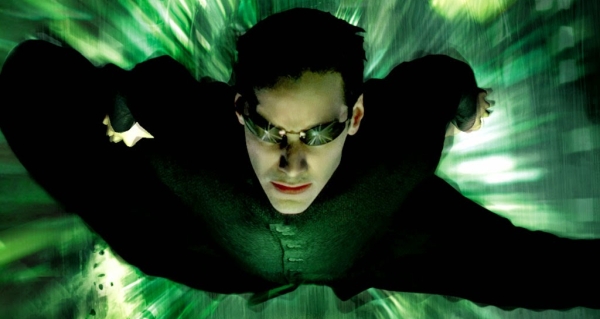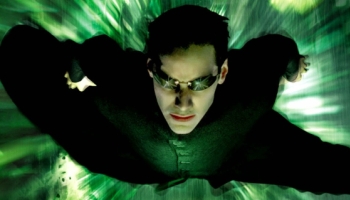
Even though its fast approaching the silver anniversary of its release, The Matrix still feels like a modern blockbuster to me. Maybe I just don’t want to admit how long its actually been, or maybe the eternal agelessness of Keanu Reeves, Carrie-Anne Moss, and Hugo Weaving has permanently trapped my brain in 1999 (my apologies to Laurence Fishburne and Joe Pantoliano).
Whatever the reason, it’s still great to go back and experience The Matrix all over again today. The gravity-defying fight scenes and its green-tinged cyberpunk aesthetic have forever etched the movie in our collective consciousness… and cast a long shadow over the game industry thanks to titles like Max Payne, Metal Gear Solid 2: Sons of Liberty, Control, and Nier: Automata.
But The Matrix also had a more direct inspiration on three incredibly ambitious tie-in games (Enter the Matrix, The Matrix: Path of Neo, and The Matrix Online) that were produced between 2003 and 2005. Let’s see how deep that rabbit hole goes…
 Insert Quarter is a glimpse into gaming’s past, present, and future through an exploration of historical, retrospective, and contemporary reporting.
Insert Quarter is a glimpse into gaming’s past, present, and future through an exploration of historical, retrospective, and contemporary reporting.
Before anyone was ever told what The Matrix was, Warner Bros. and the Wachowskis were interested in creating a tie-in game for the would-be franchise. One of the developers they approached was Dave Perry’s Shiny Entertainment. The directors were huge fans of MDK, a rather unique third-person shooter from 1997, and they thought the team would be well-suited to bring The Matrix to game consoles. But Perry turned them down and their collaboration would have to wait for another day.
The Matrix was a huge hit upon its release in 1999, leaving the Wachowskis free to expand their creation with a multi-tentacled media blitz. They teamed up with their favorite anime studios to produce The Animatrix, an animated prequel/interquel to the franchise, and they recruited writers such as Neil Gaiman and Dave Gibbons for a series of Matrix Comics.
They also finally partnered with Perry on Enter the Matrix, which was pitched as more than a tie-game when it was released for the GameCube, PC, PS2, and Xbox. Launching simultaneously alongside The Matrix Reloaded, the game was tightly integrated with the sequel’s overarching plot, taking place both before and during the events of the film. Another major bullet point for the back of the box was the inclusion of more than an hour of original film footage featuring Jada Pinkett-Smith (Niobe) and Anthony Wong (Ghost) that was directed by the Wachowskis themselves.
Writing for PC Gamer in 2019, Jeremy Peel argued that the game did more than just plug plot holes in Reloaded. It was also a flawed attempt to elevate the tie-in game:
That’s what Enter The Matrix offered. Its title was a mission statement. Rather than mimic scenes from the movies, you could become a part of their story, interwoven with the green strands of its code.
It was born from a time when Hollywood was crowning a new wave of powerful directors, a younger generation to whom the artistry of videogames was self-evident. Peter Jackson recognised a fellow auteur in Michel Ancel, and tasked the Beyond Good & Evil designer with adapting King Kong. Guillermo Del Toro was losing himself in Ico, which he declared a masterpiece. And the Wachowskis, suddenly at the head of a multimedia empire, used their position to work with as many of their favourite artists as they could. They commissioned Neil Gaiman to write a comic; in Tokyo, Madhouse and Studio 4°C produced anime. For the interactive counterpart, they went to the developer behind a goofy sci-fi shooter they’d been fond of in the ’90s—MDK.
Rediscovering the flawed ambition of Enter the Matrix
Matthew Byrd would expand on these thoughts for Den of Geek around the same time, as well as claiming that much of the oddness that worked its way into Enter the Matrix was probably the result of the intense involvement of the Wachowskis in the development process:
For a series that remains beloved despite sometimes coming across as the Hot Topic-sponsored fever dream of someone who considered Hackers to be their Rebel Without a Cause, it seems odd that there’s a major entry into The Matrix franchise that most people never talk about. It’s a video game called Enter the Matrix that was released in 2003, not as an adaptation or cash-in, but as a part of The Matrix‘s grand narrative.
Enter the Matrix is a game that not only shouldn’t have been so easily forgotten but one that we should still be talking about today. After all, it was a downright insane attempt at being something different.
Why Enter the Matrix Was Even Stranger Than the Movies
While Enter the Matrix sold well, the game was dismissed by critics and players due to its awkward controls and absolutely bizarre gameplay beats. And the cold response that film fans gave to Reloaded and Revolutions seemingly put an end to the franchise.
Even after all they’d been through, the Wachowskis still had plans for The Matrix, and they teamed up with Shiny once again to finally give players the chance to play as Neo in 2005’s The Matrix: Path of Neo. However, the philosophically-tinged ending to the film trilogy didn’t leave a lot of room for an exciting finale. So the siblings created one.
Completely breaking the fourth wall, Path of Neo introduced the Wachowskis just before the final boss battle and went on to completely rewrite the end of Neo’s saga… complete with a skyscraper-sized version of Agent Smith and a triumphant version of Queen’s “We Are the Champions.”
Alex Kane recently spoke to Perry, and several other developers from Shiny, to learn more about this literal director’s cut for Polygon:
When it came time to deliver a second game in 2005, the Matrix trilogy had come and gone, and the Wachowskis’ approach to the material began to change. The Enter the Matrix sequel would give fans the chance to play as Keanu Reeves’s prophesied hero — the one called Neo. But the visionary filmmakers wanted to take things a step further. This wouldn’t be a straightforward adaptation of the movies; the Wachowskis saw Path of Neo as a chance to give their story an alternative ending.
An oral history of The Matrix video games and their bonkers alternate ending
While Path of Neo was concerned with giving players the chance to go back, the Wachowskis viewed 2005’s The Matrix Online as the way forward. The MMO would serve as a canonical sequel to the film trilogy, and a way for a handpicked team of developers (with oversight from the directors) to further expand the mythology behind the franchise.
But while the broad strokes of the game’s structure were overseen and approved by the Wachowskis, the characters (both new and old) often veered off into strange new directions. In the weeks and months leading up to the release of the long-delayed fourth film, The Matrix Resurrections, fans wondered if any of these events would still remain canon to the story.
Seraphina Brennan chronicled some of these plotlines (including an assassin made of flies and a very famous death) for Massively shortly after the MMO was taken offline:
Yes, The Matrix Online sucked. Its gameplay was an abhorrent pile of repetitive garbage that offered no real direction other than doing storyline-less missions until you hit 50, in which there was no endgame. The combat was interesting, as it offered scripted camera shots for insane kung-fu flips and hits, but it wasn’t enough to “save” the game. I hear you.
But if you think the above paragraph is all The Matrix Online had to offer, then you are sadly mistaken.
What you missed in The Matrix Online
The Matrix Online sputtered to a close in 2009, and as the playerbase began to shrink, the development team at Monolith Productions did likewise. In the end, just a single designer, Ben Chamberlain, was working full-time on the MMO. Robert Purchese tracked down Chamberlain for a chat on Eurogamer just after the first trailer for Resurrections debuted in theaters:
I wanted to find out more, and who better to tell me than the person, who, by the end of The Matrix Online’s operation, was pretty much running the game by himself? He’d create the storylines, implement them, and then bring them to life, embodying the characters involved in them. He’d play as the Agents, wielding fancy dev tools to enhance their abilities; he’d play as named characters from the films, like the Merovingian – remember him?; he’d even create powerful new characters of his own like the Apothecary, a character so deadly she could one-hit people with powerful kill codes.
He is our Architect, and his name is Ben Chamberlain. “I was the last full-time developer on the game.”
The One: meeting the solo developer who took The Matrix Online to the end
In ways both big and small, video games sit at the center of The Matrix Resurrections.
Inside the sequel’s reprogrammed version of The Matrix, Thomas Anderson has been reborn as a game designer, and it repositions the events of the first three films as a groundbreaking trilogy of games that depict a war between humans and machines. Resurrections examines how players explore the concepts of free will and predetermination in interactive fiction, and it also briefly foregrounds modern gameplay concepts such as warp zones, God Mode, faceless enemy hordes, and the industry’s fascination with guns.
It’s weird and it’s wild, and it’s probably the only way you could make a Matrix sequel in 2021 (though whether it was a successful sequel has divided critics and audiences alike).
The Wachowskis even took another crack at creating a video game based on The Matrix. Partnering with Epic Games, The Matrix Awakens is a free download for the PS5 and Xbox Series X|S. Described as a “boundary-pushing cinematic and open-world interactive tech demo,” the game was built to showcase the possibilities of Epic’s Unreal Engine 5.
Is this the end for The Matrix as both a film franchise and a game series? It seems likely, but fans will probably follow the White Rabbit wherever the Wachowskis take us.

